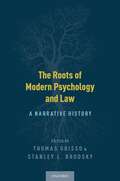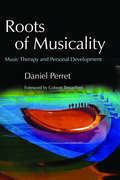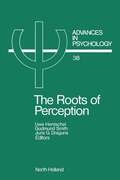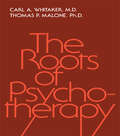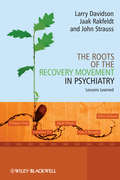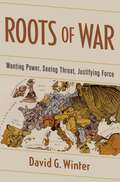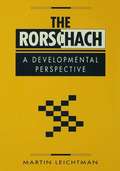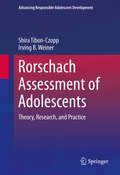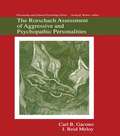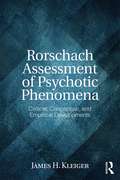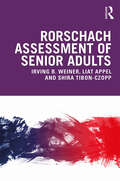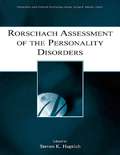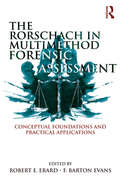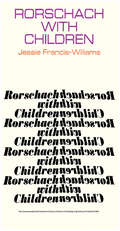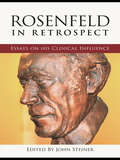- Table View
- List View
The Roots of Modern Psychology and Law: A Narrative History
Psychology's formal interaction with law began early in the twentieth century, though little in the way of substantive scholarly and professional development occurred until several decades later. The emergence of psychology and law as a modern field of scholarship was marked by the founding of the American Psychology-Law Society (AP-LS) in 1969, now approaching its 50th anniversary. The scientific foundation upon which the modern field now rests was established by a small group of psychological researchers, legal scholars, and clinicians. The Roots of Modern Psychology and Law: A Narrative History reveals how the field developed during the first decade following the founding of the American Psychology-Law Society. The contributors to this edited volume, widely considered to be among the "founders" of the field, were responsible for establishing and nurturing many of the subfields and topics in psychology and law or forensic psychology that flourished across the next fifty years. In each chapter, these leaders explain in narrative form how and why the field and the Society developed in its early years through the recounting of key professional events in their careers during the 1970s. In some cases this was their first major research study using psychology applied to legal issues. In others it was their development of seminal ideas or organizational innovations that had a later impact on the field's development. The volume chronicles how an emerging AP-LS and field of psychology and law were shaped by these psychologists, and how their own initial work was, in turn, shaped by the organization.
Roots of Musicality: Music Therapy and Personal Development (PDF)
by Colwyn Trevarthen Daniel PerretRoots of Musicality offers an accessible and original theoretical approach to a holistic music therapy based on the notion of musicality as an expression of self, with the power to energise, balance and harmonise. The author considers neuroscience and psychobiology to identify analogies with the potential of musical expression to bring about therapeutic change, as observed during his work with children with autistic spectrum and pervasive developmental disorders. Perret also explores the five elements - earth, water, fire, air and space - as means of connecting nature and human spirit. Taken together, these two approaches are instrumental in bridging the gap between music and life and fostering the expression and development of personal energy and spirit in a range of contexts, from arts therapy, music education, performance, and personal and spiritual growth. Roots of Musicality is a key text for music therapists, art therapists, sound healers, music teachers and musicians. It will be of particular interest to those using music therapy with children on the autism spectrum.
The Roots of Perception: Individual Differences in Information Processing Within and Beyond Awareness (ISSN #Volume 38)
by U. Hentschel G. Smith J. G. DragunsThe subject matter of this book is subliminal perception and microgenetic perceptual processing, two important topics on the interface between perception and personality. It presents a different way of handling these topics, biological in its emphasis on process, humanistic in its focussing on the dynamics of individual experience. The reader will not only find new theoretical perspectives but a host of new, efficient and penetrating methods for analyzing problems of personality and psychopathology. The book is filled with empirical data supporting its theoretical and methodological claims.Main Features: - New perspectives on information processing in relation to personality. - New methods applicable in many fields, such as clinical psychology, developmental and personality psychology, psychiatry, neuroscience, education (creativity), etc. - Constructive analysis and critical review of the fields of subliminal perception and microgenesis.
Roots Of Psychotherapy
by Carl A. Whitaker Thomas P. MaloneFirst published in 1994. Routledge is an imprint of Taylor & Francis, an informa company.
Roots Of Psychotherapy (Classics In Psychoanalysis And Psychotherapy Ser. #No.9)
by Carl A. Whitaker Thomas P. MaloneFirst published in 1994. Routledge is an imprint of Taylor & Francis, an informa company.
The Roots of the Recovery Movement in Psychiatry: Lessons Learned
by Larry Davidson Jaak Rakfeldt John StraussAs the global psychiatric community enters a new era of transformation, this book explores lessons learned from previous efforts with the goal of “getting it right” this time. In response to the common refrain that we know about and ‘do’ recovery already, the authors set the recovery movement within the conceptual framework of major thinkers and achievers in the history of psychiatry, such as Philippe Pinel, Dorothea Dix, Adolf Meyer, Harry Stack Sullivan, and Franco Basaglia. The book reaches beyond the usual boundaries of psychiatry to incorporate lessons from related fields, such as psychology, sociology, social welfare, philosophy, political economic theory, and civil rights. From Jane Addams and the Settlement House movement to Martin Luther King, Jr., and Gilles Deleuze, this book identifies the less well-known and less visible dimensions of the recovery concept and movement that underlie concrete clinical practice. In addition, the authors highlight the limitations of previous efforts to reform and transform mental health practice, such as the de-institutionalization movement begun in the 1950s, in the hope that the field will not have to repeat these same mistakes. Their thoughtful analysis and valuable advice will benefit people in recovery, their loved ones, the practitioners who serve them, and society at large. Foreword by Fred Frese, Founder of the Community and State Hospital Section of the American Psychological Association and past president of the National Mental Health Consumers' Association
The Roots of the Recovery Movement in Psychiatry: Lessons Learned
by Larry Davidson Jaak Rakfeldt John StraussAs the global psychiatric community enters a new era of transformation, this book explores lessons learned from previous efforts with the goal of “getting it right” this time. In response to the common refrain that we know about and ‘do’ recovery already, the authors set the recovery movement within the conceptual framework of major thinkers and achievers in the history of psychiatry, such as Philippe Pinel, Dorothea Dix, Adolf Meyer, Harry Stack Sullivan, and Franco Basaglia. The book reaches beyond the usual boundaries of psychiatry to incorporate lessons from related fields, such as psychology, sociology, social welfare, philosophy, political economic theory, and civil rights. From Jane Addams and the Settlement House movement to Martin Luther King, Jr., and Gilles Deleuze, this book identifies the less well-known and less visible dimensions of the recovery concept and movement that underlie concrete clinical practice. In addition, the authors highlight the limitations of previous efforts to reform and transform mental health practice, such as the de-institutionalization movement begun in the 1950s, in the hope that the field will not have to repeat these same mistakes. Their thoughtful analysis and valuable advice will benefit people in recovery, their loved ones, the practitioners who serve them, and society at large. Foreword by Fred Frese, Founder of the Community and State Hospital Section of the American Psychological Association and past president of the National Mental Health Consumers' Association
Roots of War: Wanting Power, Seeing Threat, Justifying Force
by David G. WinterEver since Thucydides pondered reasons for the outbreak of the Peloponnesian War, writers, philosophers, and social scientists have tried to identify factors that promote conflict escalation: for example, history (tomorrow's wars are often rooted in yesterday's conflicts), changing balance of power among nations, or domestic political forces. In the end, however, these "causes" are constructed by human beings and involve the memories, emotions, and motives of both the leaders and the led. In July 1914, the long-standing peace of Europe was shattered when the Sarajevo assassinations quickly escalated to World War I. In contrast, at the height of the Cold War, the Cuban Missile Crisis could have easily plunged the world into a thermonuclear world war, but was ultimately peacefully resolved. Why the different outcomes? In Roots of War: Wanting Power, Seeing Threat, Justifying Force, David G. Winter identifies three psychological factors that contributed to the differences in these historical outcomes: the desire for power, exaggerated perception of the opponent's threat, and justification for using military force. Several lines of research establish how these factors lead to escalation and war: comparative archival studies of "war" and "peace" crises, laboratory experiments on threat perception, and surveys of factors leading people to believe that a particular war is "just." The research findings in Roots of War also demonstrate the importance of power in preserving peace through diplomatic interventions, past and present.
Roots of War: Wanting Power, Seeing Threat, Justifying Force
by David G. WinterEver since Thucydides pondered reasons for the outbreak of the Peloponnesian War, writers, philosophers, and social scientists have tried to identify factors that promote conflict escalation: for example, history (tomorrow's wars are often rooted in yesterday's conflicts), changing balance of power among nations, or domestic political forces. In the end, however, these "causes" are constructed by human beings and involve the memories, emotions, and motives of both the leaders and the led. In July 1914, the long-standing peace of Europe was shattered when the Sarajevo assassinations quickly escalated to World War I. In contrast, at the height of the Cold War, the Cuban Missile Crisis could have easily plunged the world into a thermonuclear world war, but was ultimately peacefully resolved. Why the different outcomes? In Roots of War: Wanting Power, Seeing Threat, Justifying Force, David G. Winter identifies three psychological factors that contributed to the differences in these historical outcomes: the desire for power, exaggerated perception of the opponent's threat, and justification for using military force. Several lines of research establish how these factors lead to escalation and war: comparative archival studies of "war" and "peace" crises, laboratory experiments on threat perception, and surveys of factors leading people to believe that a particular war is "just." The research findings in Roots of War also demonstrate the importance of power in preserving peace through diplomatic interventions, past and present.
The Rorschach: A Developmental Perspective
by Martin LeichtmanMartin Leichtman's The Rorschach is a work of stunning originality that takes as its point of departure a circumstance that has long confounded Rorschach examiners. Attempts to use the Rorschach with young children yield results that are inconsistent if not comical. What, after all, does one make of a protocol when the child treats a card like a frisbee or confidently detects "piadigats" and "red foombas"? A far more consequential problem facing examiners of adults and children alike concerns the very nature of the Rorschach test. Despite voluminous literature establishing the personality correlates of particular Rorschach scores, neither Hermann Rorschach nor his intellectual descendants have provided an adequate explanation of precisely what the subject is being asked to do. Is the Rorschach a test of imagination? Of perception? Of projection? In point of fact, Leichtman argues, the two problems are intimately related. To appreciate the stages through which children gradually master the Rorschach in its standard form is to discover the nature of the test itself. Integrating his developmental analysis with an illuminating discussion of the extensive literature on test administration, scoring, and interpretation, Leichtman arrives at a new understanding of the Rorschach as a test of representation and creativity. This finding, in turn, leads to an intriguing reconceptualization of all projective tests that clarifies their relationships to more objective measures of ability.
The Rorschach: A Developmental Perspective
by Martin LeichtmanMartin Leichtman's The Rorschach is a work of stunning originality that takes as its point of departure a circumstance that has long confounded Rorschach examiners. Attempts to use the Rorschach with young children yield results that are inconsistent if not comical. What, after all, does one make of a protocol when the child treats a card like a frisbee or confidently detects "piadigats" and "red foombas"? A far more consequential problem facing examiners of adults and children alike concerns the very nature of the Rorschach test. Despite voluminous literature establishing the personality correlates of particular Rorschach scores, neither Hermann Rorschach nor his intellectual descendants have provided an adequate explanation of precisely what the subject is being asked to do. Is the Rorschach a test of imagination? Of perception? Of projection? In point of fact, Leichtman argues, the two problems are intimately related. To appreciate the stages through which children gradually master the Rorschach in its standard form is to discover the nature of the test itself. Integrating his developmental analysis with an illuminating discussion of the extensive literature on test administration, scoring, and interpretation, Leichtman arrives at a new understanding of the Rorschach as a test of representation and creativity. This finding, in turn, leads to an intriguing reconceptualization of all projective tests that clarifies their relationships to more objective measures of ability.
Rorschach Assessment of Adolescents: Theory, Research, and Practice (Advancing Responsible Adolescent Development #182)
by Shira Tibon-Czopp Irving B. WeinerThis book serves as an up-to-date Rorschach primer and elaborates on the various applications of Rorschach assessment for adolescents with respect to differential diagnosis, forensic consultation, and therapeutic assessment. It opens with three chapters that provide readers with a basic overview and introduction to the topics integrated throughout the text. The first reviews the development and foundations of the Rorschach Inkblot Method; the second discusses key issues in the assessment of adolescents, with particular attention to differentiating patterns of psychopathology from normal developmental variations; and the third presents general considerations in using performance-based assessment instruments in the assessment of personality functioning in adolescence. Later chapters explore the current status of the Rorschach Inkblot Method with respect to theoretical formulations, research findings, and practice guidelines. The final chapter draws on information in the preceding chapters to present a model for Rorschach assessment of adolescents. This model is designed to facilitate accurate and useful formulations of personality functioning that contribute substantially to advancing responsible adolescent development.
The Rorschach Assessment of Aggressive and Psychopathic Personalities (Personality and Clinical Psychology)
by Carl B. Gacono J. Reid MeloyThis book provides a definitive empirical study of antisocial character pathology and its assessment through the use of the Rorschach. Drawing upon a decade of research with nearly 400 individuals in various hospitals and prisons, the authors paint an extraordinary intrapsychic picture of the personality structure and psychodynamics of these troublesome patients.Serving as both an educational tool and a reference text, this book presents: * Rorschach data on several different antisocial groups -- conduct disordered children and adolescents, antisocial personality disordered adult males with and without schizophrenia, antisocial adult females, and male and female sexual homicide perpetrators; * nomothetic (group) and idiographic (case study) data; * data which have been analyzed and theoretically interpreted using both structural methods and psychoanalytic approaches which represent the cutting edge of Rorschach theory and practice; and* a developmental approach in analyzing Rorschach data gathered from antisocial children, adolescents, and adults -- providing striking similarities. This is the first Rorschach database of this type that has ever been published. As such, it serves as a valuable reference text for Rorschach users -- providing a definitive empirical base, theoretical integration, and a focus on individuals who create severe problems for society.
The Rorschach Assessment of Aggressive and Psychopathic Personalities (Personality and Clinical Psychology)
by Carl B. Gacono J. Reid MeloyThis book provides a definitive empirical study of antisocial character pathology and its assessment through the use of the Rorschach. Drawing upon a decade of research with nearly 400 individuals in various hospitals and prisons, the authors paint an extraordinary intrapsychic picture of the personality structure and psychodynamics of these troublesome patients.Serving as both an educational tool and a reference text, this book presents: * Rorschach data on several different antisocial groups -- conduct disordered children and adolescents, antisocial personality disordered adult males with and without schizophrenia, antisocial adult females, and male and female sexual homicide perpetrators; * nomothetic (group) and idiographic (case study) data; * data which have been analyzed and theoretically interpreted using both structural methods and psychoanalytic approaches which represent the cutting edge of Rorschach theory and practice; and* a developmental approach in analyzing Rorschach data gathered from antisocial children, adolescents, and adults -- providing striking similarities. This is the first Rorschach database of this type that has ever been published. As such, it serves as a valuable reference text for Rorschach users -- providing a definitive empirical base, theoretical integration, and a focus on individuals who create severe problems for society.
Rorschach Assessment of Psychotic Phenomena: Clinical, Conceptual, and Empirical Developments
by James H. KleigerRorschach Assessment of Psychotic Phenomena takes the reader beyond where James H. Kleiger’s original work, Disordered Thinking and the Rorschach, left off. This new book offers readers a number of conceptual bridges between Rorschach characteristics commonly associated with psychotic phenomena and a range of psychological, neurocognitive, and psychoanalytic constructs that help psychologists move beyond static, test-bound interpretations of scores and indices. Beginning with a broad-based understanding of disordered thinking and reality testing, Kleiger provides an updated review of the contributions of past Rorschach luminaries and contemporary figures who have helped make the Rorschach a robust tool for assessing aspects of psychotic-level experience. The contributions of major figures are highlighted and assessed in terms of their empirical, conceptual, and practical implications. In addition to providing a balanced, respectful review of each of these leading figures and the systems they developed, Kleiger offers a new way of organizing and conceptualizing what is currently understood about Rorschach scoring variables pertaining to psychotic phenomena. Kleiger’s aim is to help Rorschach practitioners not only consolidate their grasp of key scoring variables and what each means about an individual’s thought processes and internal experiences, but also expand their clinical understanding of the psychotic phenomena being assessed. He includes a wide range of psychotic phenomena, like negative symptoms, cognitive impairment, magical thinking, and impairment of insight, all of which are subjects of diagnostic interest when using the Rorschach with psychotically prone individuals. The final section on psychopathology looks at how the Rorschach is useful in differential diagnosis of primary psychoses and those conditions that may include secondary psychotic phenomena. In step with contemporary DSM-5 standards, Kleiger organizes his discussion of severe psychopathology in a manner consistent with how psychotic phenomena are currently understood in the clinical and scientific literature. In addition to reviewing key clinical characteristics of these conditions, along with Rorschach contributions to the diagnosis of these disorders, he also focuses his lens on the Rorschach assessment of malingered psychosis and psychotic phenomena in children and adolescents. Written with the same well-researched attention to detail and integrative style as Kleiger's earlier work, Rorschach Assessment of Psychotic Phenomena will prove invaluable to clinical psychologists, psychiatrists, and psychoanalysts interested in understanding and assessing psychosis.
Rorschach Assessment of Psychotic Phenomena: Clinical, Conceptual, and Empirical Developments
by James H. KleigerRorschach Assessment of Psychotic Phenomena takes the reader beyond where James H. Kleiger’s original work, Disordered Thinking and the Rorschach, left off. This new book offers readers a number of conceptual bridges between Rorschach characteristics commonly associated with psychotic phenomena and a range of psychological, neurocognitive, and psychoanalytic constructs that help psychologists move beyond static, test-bound interpretations of scores and indices. Beginning with a broad-based understanding of disordered thinking and reality testing, Kleiger provides an updated review of the contributions of past Rorschach luminaries and contemporary figures who have helped make the Rorschach a robust tool for assessing aspects of psychotic-level experience. The contributions of major figures are highlighted and assessed in terms of their empirical, conceptual, and practical implications. In addition to providing a balanced, respectful review of each of these leading figures and the systems they developed, Kleiger offers a new way of organizing and conceptualizing what is currently understood about Rorschach scoring variables pertaining to psychotic phenomena. Kleiger’s aim is to help Rorschach practitioners not only consolidate their grasp of key scoring variables and what each means about an individual’s thought processes and internal experiences, but also expand their clinical understanding of the psychotic phenomena being assessed. He includes a wide range of psychotic phenomena, like negative symptoms, cognitive impairment, magical thinking, and impairment of insight, all of which are subjects of diagnostic interest when using the Rorschach with psychotically prone individuals. The final section on psychopathology looks at how the Rorschach is useful in differential diagnosis of primary psychoses and those conditions that may include secondary psychotic phenomena. In step with contemporary DSM-5 standards, Kleiger organizes his discussion of severe psychopathology in a manner consistent with how psychotic phenomena are currently understood in the clinical and scientific literature. In addition to reviewing key clinical characteristics of these conditions, along with Rorschach contributions to the diagnosis of these disorders, he also focuses his lens on the Rorschach assessment of malingered psychosis and psychotic phenomena in children and adolescents. Written with the same well-researched attention to detail and integrative style as Kleiger's earlier work, Rorschach Assessment of Psychotic Phenomena will prove invaluable to clinical psychologists, psychiatrists, and psychoanalysts interested in understanding and assessing psychosis.
Rorschach Assessment of Senior Adults (Connections Ser.)
by Irving Weiner Liat Appel Shira Tibon-CzoppThis guide is a much-needed reference for clinicians on how to use the Rorschach Inkblot Test with senior adults, an essential tool for assessing personality functioning to better identify psychological interventions. The book integrates historical developments, current research, conceptual considerations, and therapeutic and diagnostic applications. Chapters review basic guidelines for the understanding and interpretation of Rorschach variables, including protocol validity; interpretation of structural variables, thematic imagery, and cross-cultural normative data; sequence analysis; and more. The authors then provide 10 case illustrations of how the Rorschach indices of cognitive functioning, emotional experience, interpersonal relatedness, and self-perception can facilitate differential diagnosis and treatment planning in clinical work with older people. These case illustrations are rooted in previously non-existent Rorschach reference data based on an international sample of more than 250 senior adults and a second sample of more than 200 patients with Alzheimer’s disease. Clinicians will come away with a solid empirical basis for distinguishing between normal-range personality functioning and manifestations of psychological disorder in the elderly and for providing beneficial interventions to senior adult patients.
Rorschach Assessment of Senior Adults
by Irving Weiner Liat Appel Shira Tibon-CzoppThis guide is a much-needed reference for clinicians on how to use the Rorschach Inkblot Test with senior adults, an essential tool for assessing personality functioning to better identify psychological interventions. The book integrates historical developments, current research, conceptual considerations, and therapeutic and diagnostic applications. Chapters review basic guidelines for the understanding and interpretation of Rorschach variables, including protocol validity; interpretation of structural variables, thematic imagery, and cross-cultural normative data; sequence analysis; and more. The authors then provide 10 case illustrations of how the Rorschach indices of cognitive functioning, emotional experience, interpersonal relatedness, and self-perception can facilitate differential diagnosis and treatment planning in clinical work with older people. These case illustrations are rooted in previously non-existent Rorschach reference data based on an international sample of more than 250 senior adults and a second sample of more than 200 patients with Alzheimer’s disease. Clinicians will come away with a solid empirical basis for distinguishing between normal-range personality functioning and manifestations of psychological disorder in the elderly and for providing beneficial interventions to senior adult patients.
Rorschach Assessment of the Personality Disorders (Personality and Clinical Psychology)
by Steven K. HuprichFor decades, The Rorschach Inkblot Method (RIM)--the most popular of the projective tests--has been routinely employed for personality assessment and treatment planning. But in recent years, it has not been free from controversy. Criticisms of its validity and empirical support are catalyzing new efforts to strengthen its foundations and document its broad utility. Among the most common--yet also most confusing and challenging--categories of clinical disorders is the personality disorders. However, minimal data have been available on the RIM evaluation of most of those found in DSM-IV. This welcomed book constitutes the first research-grounded, comprehensive guide to the use of the RIM in assessing personality disorders. The first section offers a theoretical overview of personality disorders and constructs a framework and compelling rationale for the legitimate role of the RIM in their assessment. The second, third, and fourth sections present Cluster A disorders--paranoid, schizoid, and schizotypal; Cluster B disorders--antisocial and psychopathic, borderline, histrionic, and narcissistic; and Cluster C disorders--avoidant, dependent, and obsessive-compulsive. The fifth section presents passive aggressive and depressive personality disorders, currently being proposed for DSM inclusion. Each chapter in these four sections includes an extensive description of the disorder, a review of empirical studies of the use of the RIM to assess it, an analysis of the Rorschach variables that may characterize patients diagnosed with it, and a depiction of a real case and discussion of the ways in which the RIM contributed to its formulation. The sixth and final section explores the relationship between psychoanalytic theory and the RIM. Rorschach Assessment of the Personality Disorders brings practical help for clinicians and clinicians-in-training, and suggests new paths for researchers seeking to advance our understanding of the complexities of these disorders.
Rorschach Assessment of the Personality Disorders (Personality and Clinical Psychology)
by Steven K. HuprichFor decades, The Rorschach Inkblot Method (RIM)--the most popular of the projective tests--has been routinely employed for personality assessment and treatment planning. But in recent years, it has not been free from controversy. Criticisms of its validity and empirical support are catalyzing new efforts to strengthen its foundations and document its broad utility. Among the most common--yet also most confusing and challenging--categories of clinical disorders is the personality disorders. However, minimal data have been available on the RIM evaluation of most of those found in DSM-IV. This welcomed book constitutes the first research-grounded, comprehensive guide to the use of the RIM in assessing personality disorders. The first section offers a theoretical overview of personality disorders and constructs a framework and compelling rationale for the legitimate role of the RIM in their assessment. The second, third, and fourth sections present Cluster A disorders--paranoid, schizoid, and schizotypal; Cluster B disorders--antisocial and psychopathic, borderline, histrionic, and narcissistic; and Cluster C disorders--avoidant, dependent, and obsessive-compulsive. The fifth section presents passive aggressive and depressive personality disorders, currently being proposed for DSM inclusion. Each chapter in these four sections includes an extensive description of the disorder, a review of empirical studies of the use of the RIM to assess it, an analysis of the Rorschach variables that may characterize patients diagnosed with it, and a depiction of a real case and discussion of the ways in which the RIM contributed to its formulation. The sixth and final section explores the relationship between psychoanalytic theory and the RIM. Rorschach Assessment of the Personality Disorders brings practical help for clinicians and clinicians-in-training, and suggests new paths for researchers seeking to advance our understanding of the complexities of these disorders.
The Rorschach in Multimethod Forensic Assessment: Conceptual Foundations and Practical Applications
by Robert E. Erard F. Barton EvansThis volume demonstrates how multimethod forensic assessment with the Rorschach adds incremental validity, insight, and practical value. Case discussions by leading forensic psychologists illustrate the integration of contemporary Rorschach assessment with the MMPI-2 and MMPI-2-RF, the PAI, and the HCR-20. This text addresses a wide range of forensic applications including child custody, psychological trauma, personal injury, psychotic offenders, competency evaluations, immigration cases, and impression management. It also shows how the recently developed Rorschach Performance Assessment System (R-PAS) effectively enhances the use of the Rorschach in forensic cases, while offering guidance for Comprehensive System users as well.
The Rorschach in Multimethod Forensic Assessment: Conceptual Foundations and Practical Applications
by Robert E. Erard F. Barton EvansThis volume demonstrates how multimethod forensic assessment with the Rorschach adds incremental validity, insight, and practical value. Case discussions by leading forensic psychologists illustrate the integration of contemporary Rorschach assessment with the MMPI-2 and MMPI-2-RF, the PAI, and the HCR-20. This text addresses a wide range of forensic applications including child custody, psychological trauma, personal injury, psychotic offenders, competency evaluations, immigration cases, and impression management. It also shows how the recently developed Rorschach Performance Assessment System (R-PAS) effectively enhances the use of the Rorschach in forensic cases, while offering guidance for Comprehensive System users as well.
Rorschach with Children: A Comparative Study of the Contribution Made by the Rorschach and Other Projective Techniques to Clinical Diagnosis in Work with Children
by Jessie Francis-WilliamsRorschach with Children shows the use of Rorschach test as an aid in clinical diagnoses of children. Other tools of clinical analysis as well as different projective techniques are described in the book as a point of comparison. The book also provides a short description of the scoring categories used for the interpretation of the result of the test. A section of the book is devoted to the discussion of the theories underlying the concept of projections. The book begins with some historical background of psychology with emphasis on the different psycho analytical tools that were used at the time. This section is followed by categories that classify certain projective techniques. The personalities who started some of these projective techniques along with some illustrations of the pictures used for projections are found in the book. The book will be a valuable tool for clinical psychologists, psychiatrists, students, and researchers in the field of psychology.
Rosenfeld in Retrospect: Essays on his Clinical Influence
by John SteinerHow has Herbert Rosenfeld contributed to psychoanalysis today? Rosenfeld in Retrospect presents original psychoanalytic papers showing the influence of Herbert Rosenfeld on psychoanalysis today, and reproduces some of Rosenfeld's most important clinical writings. In the first part of this book, The Conference Papers: Contemporary Developments of Rosenfeld's Work, the editor brings together papers and discussions by Rosenfeld's well-known contemporaries, Ronald Britton, Michael Feldman, Edna O'Shaughnessy, Hanna Segal and Riccardo Steiner who explore his contribution to psychoanalysis. John Steiner demonstrates the importance of Rosenfeld's classic papers, and critically surveys the more controversial developments in his later work. Part II contains four papers by Rosenfeld, chosen by his colleagues to be his most significant and original contributions. This collection conveys Rosenfeld's liveliness and influence, and will be of interest to all of those attracted to his work.
Rosenfeld in Retrospect: Essays on his Clinical Influence
by John SteinerHow has Herbert Rosenfeld contributed to psychoanalysis today? Rosenfeld in Retrospect presents original psychoanalytic papers showing the influence of Herbert Rosenfeld on psychoanalysis today, and reproduces some of Rosenfeld's most important clinical writings. In the first part of this book, The Conference Papers: Contemporary Developments of Rosenfeld's Work, the editor brings together papers and discussions by Rosenfeld's well-known contemporaries, Ronald Britton, Michael Feldman, Edna O'Shaughnessy, Hanna Segal and Riccardo Steiner who explore his contribution to psychoanalysis. John Steiner demonstrates the importance of Rosenfeld's classic papers, and critically surveys the more controversial developments in his later work. Part II contains four papers by Rosenfeld, chosen by his colleagues to be his most significant and original contributions. This collection conveys Rosenfeld's liveliness and influence, and will be of interest to all of those attracted to his work.
